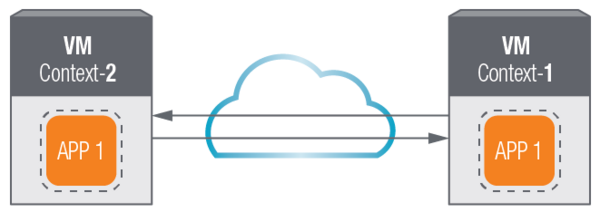Gamers are used to living in a virtualized world. Battling imaginary villains and taking castle towers. However, this is not the only virtualized world that exists today. Our computer addicted world is going virtualized in virtual machines. Like with any new technology shift, a new vocabulary emerges to describe the entities that "live in this world". With the advent of companies like VMWare, applications are now created and run in this context on "virtual" computers that allow the business world to leverage their investment in VM Software and minimize expense of real computer hardware systems.
With the virtual solutions becoming entrenched in businesses, other concepts of how to use this technology have emerged. One important evolutionary step with virtual technologies is: Network Functions Virtualization (NFV). NFV takes the basic virtual computer concept one-step further, adding design flexibility by decoupling major network application functions and allowing them to operate in independent VM contexts.

This "application body" disassociation results in a network deployment flexibility that has never before been possible. VM solutions freed businesses from physical hardware restrictions. NFV can compound that by freeing businesses from physical location restrictions. Depending upon the application and specific customer requirements, decoupled VM-NFV elements can be deployed either distributed or centralized and still be viewed as a cohesive service used to meet user needs. Additionally, the flexibility of NFV also enables better scaling of network components across a network and can have a direct impact on lowering CAPEX and TCO. There are a plethora of examples of how NFV can impact your virtual world. When taken into consideration at design time, applications can be developed to fit a segmented deployment model across multiple VM systems. If a VM system maxes out its current resources, expansion only requires deploying additional NFV-VM resources as a business or network grows. The whole solution may be co-resident in the same facility or be distributed but can be expanded seamlessly.
One obvious example where NFV can play a vital role in optimizing a network, is in managing user data flows. There are
two major classes of data streams in all computer networks:
- Control - that information which is used to configure, provision, monitor, and troubleshoot the operation of the network itself. It has nothing to do with the applications that are used on the network.
- Data - network traffic that is received or transmitted data by network nodes is support of applications.
Often user data becomes the predominant traffic on the network and whether distributed or centralized, such data may require special handling as to security and QoS. Traditionally, this was achieved through managing flows as VLANs and provisioning switches and routers to direct the flows to the correct target. This approach works but can be tedious for IT team members and limited in the desired class of services that can be implemented and sustained. Client nodes and switches/routers have to be configured which becomes increasingly cumbersome with network growth. One concept to simplify this problem is to create a NFV service that eliminates the complexity of configuring VLANs for clients and network infrastructures. Such a virtual service can aggregate user data based on SSIDs, apply encryption and policies to the data, and route that steam to the designated receivers. One natural example of this in a business context would be to collect and securely route all "guest" traffic to the Internet with a minimum of management overhead. The NFV approach requires only that special SSIDs be created at the APs and clients are no longer VLAN tagged. Aggregation happens at the access point which is then transmitted to the NFV service provider for ultimate forwarding.
An NFV approach can amplify deployment options, lower costs through proper resource scaling and amplify performance within a network. Ruckus sees real value is such an approach and has begun implementing unique NFV solutions in our virtualized SmartZone product portfolio.
 This "application body" disassociation results in a network deployment flexibility that has never before been possible. VM solutions freed businesses from physical hardware restrictions. NFV can compound that by freeing businesses from physical location restrictions. Depending upon the application and specific customer requirements, decoupled VM-NFV elements can be deployed either distributed or centralized and still be viewed as a cohesive service used to meet user needs. Additionally, the flexibility of NFV also enables better scaling of network components across a network and can have a direct impact on lowering CAPEX and TCO. There are a plethora of examples of how NFV can impact your virtual world. When taken into consideration at design time, applications can be developed to fit a segmented deployment model across multiple VM systems. If a VM system maxes out its current resources, expansion only requires deploying additional NFV-VM resources as a business or network grows. The whole solution may be co-resident in the same facility or be distributed but can be expanded seamlessly.
One obvious example where NFV can play a vital role in optimizing a network, is in managing user data flows. There are two major classes of data streams in all computer networks:
This "application body" disassociation results in a network deployment flexibility that has never before been possible. VM solutions freed businesses from physical hardware restrictions. NFV can compound that by freeing businesses from physical location restrictions. Depending upon the application and specific customer requirements, decoupled VM-NFV elements can be deployed either distributed or centralized and still be viewed as a cohesive service used to meet user needs. Additionally, the flexibility of NFV also enables better scaling of network components across a network and can have a direct impact on lowering CAPEX and TCO. There are a plethora of examples of how NFV can impact your virtual world. When taken into consideration at design time, applications can be developed to fit a segmented deployment model across multiple VM systems. If a VM system maxes out its current resources, expansion only requires deploying additional NFV-VM resources as a business or network grows. The whole solution may be co-resident in the same facility or be distributed but can be expanded seamlessly.
One obvious example where NFV can play a vital role in optimizing a network, is in managing user data flows. There are two major classes of data streams in all computer networks:






